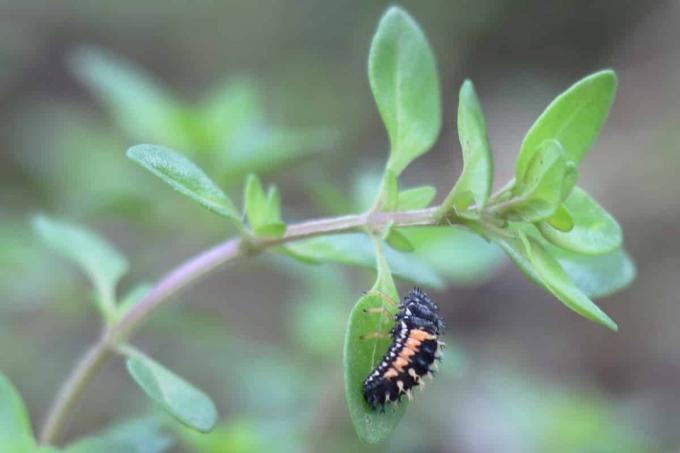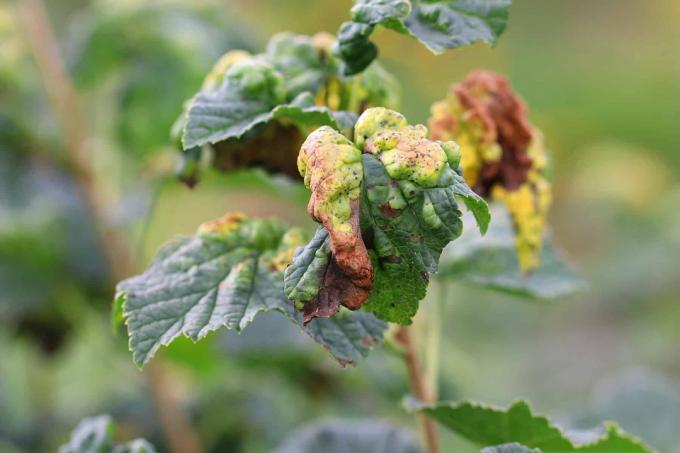

Table of contents
- Ladybug larvae in your own garden
- The winter quarters
- The food supply
- mixed cultures
- ants
- Buy and release beneficial insects
- Don't spread poison
Ladybug larvae are among the best known and most popular beneficial insects in the home garden. It helps to keep a wide variety of pests in check or to prevent them from spreading from the outset. Anyone who does not want to leave the occurrence of beneficial insects to chance can promote them in a targeted manner and favor them at their own location. We use helpful tips to explain how to safely use them in your own garden.
Ladybug larvae in your own garden
The ladybug literally brings luck to anyone who finds it or lives in their own garden. In practical terms, it can actually be described as a stroke of luck that these animals make a significant contribution to keeping pests in check. Because both the ladybug and its larvae prefer to feed on the number one garden pest - the aphid:
- E.g. Seven-spot ladybird: around 100 to 150 lice per day
- Ladybird larvae from hatching to pupation approx. 400 to 600 lice
It becomes clear that even a few animals can make an enormous contribution to containing an infestation. But don't leave their appearance in the garden to chance. Promote the beneficial insects in a targeted manner and use them optimally to your advantage:
The winter quarters
In spring, when the temperature slowly rises again after the cold winter nights, pests can multiply explosively. To ensure that the right beneficial insect is present when the aphid appears, it is worth providing the ladybird with suitable hibernation opportunities in the garden. If he finds a sufficiently high temperature for a protected hibernation without danger of frostbite, he wakes up in the spring at the same time as the lice appear and sets to work with ravenous hunger Plant. And the propagation is also much faster in favor of pest control if the beetles don't have to gradually migrate back into the garden. Good hibernation quarters with a sufficiently high temperature are:
- pile of leaves
- Deadwood with cracks, crevices and holes
- compost heap
- Cracks and cavities in garden walls, sheds, garages, etc.
- Special insect boxes
The food supply
In addition to aphids, ladybugs also like to eat pollen. A ladybird will therefore find it difficult to settle in a meticulously short-mown ornamental garden with an English lawn and precisely cut boxwood balls. On the other hand, environments that are as close to nature as possible attract it in droves and offer a good basis for all phases of the beetle's life. From there, it will be happy to hunt down the unwelcome pests for your benefit.

Ladybugs find particularly good conditions on the following plants:
- yarrow
- marigold
- dandelion
- Mustard
- sea lavender
- Alyssum
- poppy
If, on the other hand, you want to benefit from the plants yourself, use common herbs such as
- dill
- fennel
- Caraway seeds
- coriander
- chives
- chamomile
DANGER:
Keep in mind that the plants only favor the ladybug if they are actually allowed to bloom! On the other hand, if you prune, mow or otherwise remove it before flowering, you will not achieve the goal of your efforts!
mixed cultures
Use the knowledge from the last tip and make it easier for the ladybug to find the aphids in the garden. If the flowering plants are placed between the crops and ornamental plants to be protected, the Paths from pollen supply to favorite food are kept short and the beetles find their way to their destination quickly and easily secure.
A NOTICE:
Get rid of the thought that by favoring the ladybug larvae you will get a garden completely aphid-free. If there are no more aphids, the ladybug will also disappear. Ultimately, however, there will always be a balance between pests and beneficial insects. This is usually at a level that your plants do not suffer and the "infestation" can be accepted. If individual plants are particularly important to you, direct your efforts in such a way that the beetles find and eliminate the lice living there first.
ants
We humans do not like the aphid and fight it with all means. The situation is different with ants. They milk the lice and thus ensure part of their diet. Logically, the ant, as the guardian and protector of the aphids, is one of the declared enemies of the ladybugs, which in turn are only too happy to clean up the aphids. Therefore, to protect your ladybug population, you should intervene when too many ants oppose your efforts. They can be kept away from plants, for example, with:
- Strong-smelling aromatic plants such as lavender, thyme or marjoram
- Moist soil around the plant, so regular watering
- The absence of significant lice populations (early promotion of ladybugs)
DANGER:
Again and again one reads that ant nests should be doused with boiling water or destroyed with baking powder. Since the ant has numerous useful properties in addition to this unloved habit of caring for aphids, the cut quickly goes into its own flesh when the animals are killed. It is better to keep them away from plants that are particularly worthy of protection. In a healthy garden with flowering plants and a wide range of products, it is also easy to cope if a few ladybugs fall victim to the ants. In the long run, a healthy balance of ants, aphids and ladybugs will develop. Set ladybug larva.
Buy and release beneficial insects
If you do not want to trust that the spotted beetles will find their way into the garden and multiply by themselves, you can also buy and release the ladybird larvae in a targeted manner. This ensures a high population from the start. In addition, the beneficial insects can be released exactly where there is an acute need for action against lice. It is important that the living conditions in the garden are still geared towards the new visitor. On the other hand, if the conditions are not right, even deliberately released ladybird larvae migrate to other locations in the long term.

DANGER:
Many commercially available ladybird larvae do not come from the native seven-spot ladybird, but from other species that are easier to breed. These usually originate in Asia and are considered neozoons in our country. They can displace native beetles and introduce parasites and diseases.
Don't spread poison
Inexperienced gardeners often feel they need to support the natural balance of pests and beneficial insects by applying insecticides. Keep in mind that the beneficial insects, here the ladybird larva, are also insects. Many toxins act non-specifically and also kill the ladybugs. It is true that various means today promise to selectively eliminate only pests. The long-term effects on beneficial insects, on the other hand, are hardly known, so that the application of these substances usually has undesirable side effects. In addition, it is difficult for the user of the insecticides to estimate how the intervention in the natural Circulation elsewhere has an effect when simply a link in a food chain in the form of pests Will get removed.
 garden editorial
garden editorial I write about everything that interests me in my garden.
Learn more about beneficial insects

Use parasitic wasps against moths | Where can you buy them?
Their fluttering in the light cone of a lamp not only gets on your nerves, depending on the species, moths can also cause problems Damage to clothes, create an unpleasant, musty smell or make food spoil faster. In the worst case, they can even trigger allergic reactions. Ironically, conspecifics should fight the insects? But are parasitic wasps really effective or are there unpleasant side effects to be expected with this control method? And which sales outlets have the beneficial insects in their range at all? Questions over questions - here are the answers.

Predatory mites against spider mites - application - information on breeding
A small creation of nature is a serious problem for the gardener and his green plants: the spider mite. If she is approaching, no leaf is safe from her. But nature also provided us with a solution right away: the predatory mite.
Use predatory mites and breed them yourself
They are tiny and yet highly effective in pest control: predatory mites, small arachnids that feed on all sorts of other animals of their size. As a result, they make an enormous contribution to pest control and also belong on a large scale (v. a. in viticulture) among the beneficial insects worthy of protection.

Fight aphids on herbs biologically | 10 home remedies & beneficial insects
Aphids are unwelcome guests in the garden and like to spread on the tasty herbs. Unfortunately, these plants are very sensitive and suffer greatly from pest infestation, which can even lead to their death. As an antidote, biological alternatives to the chemical club are always to be preferred.

Leaf diseases on currants: leaf fall disease & Co
Diseases on the leaves are not uncommon in currants. They are triggered by fungi, viruses or various pests settle in. Many problems can be remedied with simple home remedies. Proper care also helps to prevent many diseases.

Mice species in Germany: 20 native mice
In Germany, not only field mice and house mice are native, but also some other species that you often don't see at all or only very rarely. Here we present 20 native mouse species.



